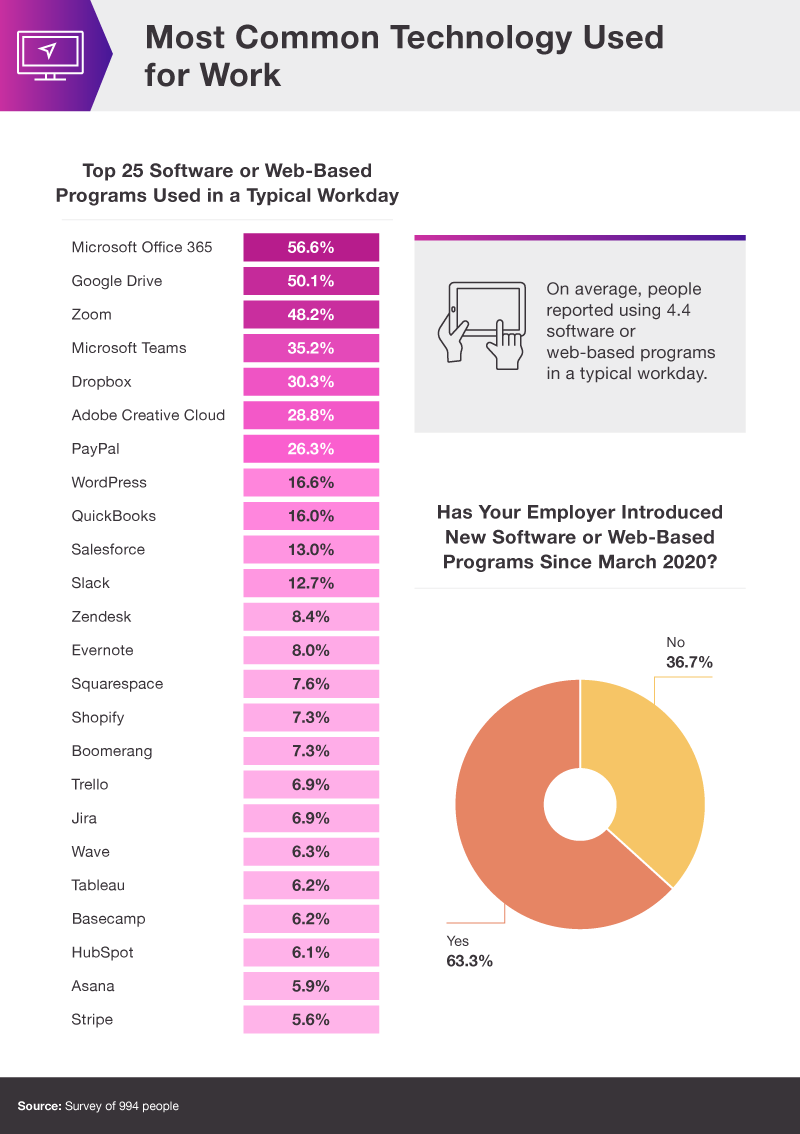Technology Knowledge in the Modern Workforce
Even before the intense changes of 2020, technology was already becoming increasingly important to the workforce. According to the LinkedIn Emerging Jobs Report, hiring for artificial intelligence specialists increased by 74% over the last four years. The number of people with coding skills is increasing by the millions, and 10% of the U.S. economy is now accounted for by the tech industry.
But even if you aren’t working in a tech-specific field like AI or web development, the modern-day workplace relies so heavily on technology that you will likely have to know at least some of it to thrive on the job or to perhaps even get hired. To look deeper into this concept, FutureLearn recently spoke to just under 1,000 people. We asked them about the technological demands of jobs, the specific programs they rely on, and the preparedness they felt their formal education provided them.
The Modern Job

Our study kicks off with a look into how technologically heavy the average job in the U.S. is today. We asked respondents to share their opinions and to reflect on how much these tech demands have increased this year.
When asked to what extent they considered their jobs to be “tech-heavy,” most respondents replied “very much” (43.7%). This means that nearly half of workers – regardless of field – are heavily relying on tech to get the job done. Moreover, when we asked about how much this reliance on tech has changed, even over the time span of that single job, an additional 43.4% said the position had already become more tech-heavy than when they had started.
In an even shorter average time frame, we wanted to also consider the impact of COVID-19. Since the pandemic began, more than half of workers said their positions had become more reliant on technology. Only a scant 3% said less tech use had been demanded of them since. With so many companies going remote at the pandemic’s onset (and now encouraging this policy long term), technology both came to the rescue while also providing a few headaches. The pandemic, was just one indicator of how quickly technology can adapt to a rapidly changing world. How well the worker can keep up, however, is an entirely separate question that we continued to explore below.
In-Demand Skills

To get into the specifics, we also asked respondents what skills they felt everyone should have before entering the workforce. Considering they are all currently employed in an incredibly turbulent economy, their advice should likely be heeded. We also asked them to reflect on whether they had learned these skills while in college.
Technology is the primary reason that workers today are more productive than ever. Technology has impacted everything from manufacturing to communication – what used to take hours in these fields now takes minutes (or even less). Payments, proposals, messages, and collaboration can all occur in an instant, so long as you know how to use the proper tools.
According to respondents, the most important of these tools to know is Microsoft Office 365. Nearly 63% of workers agreed that everyone, regardless of field, should have this knowledge when entering the workforce. This is easier said than done, however, as Microsoft Office includes an entire host of programs, each different from the next. To name just a few, this suite includes:
- Microsoft Word
- Microsoft Excel
- Microsoft PowerPoint
- Skype for Business
Consider also that only 34.5% of the employees we spoke to had learned these skills in college. This is just one indication (among many) of how quickly the needs of technology in the workplace can change, even if you’ve graduated recently.
Though Microsoft Office isn’t as complicated as something like coding (which only 23.9% insisted that workers learn for the average job today), it’s interesting to see how many schools are starting to teach this skill. This is likely because coding is itself a job that is increasingly in demand, whereas Microsoft Office is a tool for general job success. Over 45% of the people we spoke to said they had learned some coding in college.
A Typical Day on the Job Today

Even without a drop of technological skill, there are often workarounds or more tech-savvy co-workers people can lean on. But then there are the daily tasks that a worker must really rely on themselves to maintain effectiveness in their day-to-day work. This next part of the study looks at those skills that people are using during their typical workday.
Microsoft Office may be the most important program for workers to know today, at least as far as frequency of use is concerned: 56.6% of workers said they used this on a typical day at work. Considering this program often provides the very documents with which people work from, it’s certainly a crucial skill and perhaps non-negotiable in many offices. If this is of concern, know that the basics are fairly simple and tips and instructions can often be found online or even within the program. More advanced knowledge, particularly for Microsoft programs like Excel, will require more time and resources but can provide a leg up in the increasingly tech-dependent world.
Microsoft Office may have easily been considered just as important to know before COVID-19. Zoom, which nearly half (48.2%) of workers use today on a daily basis, has provided a lifeline to workers in a COVID-driven world. With such a huge number of workers going remote, Zoom has provided the ability to connect and host meetings regardless of employee location. If we’re strictly focused on Zoom’s market value increase this year, it’s essentially six times more important today than it was pre-pandemic. But it’s certainly not the only program that has become more important in that same time frame: 63.3% of workers said their employer had introduced new software or web-based programs since March of 2020.
Employee Preparedness

With the need for technological skills established, the next portion of this study looks at how well typical education prepared employees for the jobs they carry out today.
Technology evolves faster than employee skills, and as such faster than a standard college curriculum possibly could. Most people felt their education prepared them “somewhat well” for their current position, with higher perceptions of preparation from college.
This “somewhat well” response often translated into a lack of preparedness. When asked if they had felt held back at some point in their careers, 54.5% said yes and specifically because of a lack of the necessary technical skills. Women were even more likely to feel this way. Even in 2020, the number of women in tech remained very small compared to men.
Formal Education Alternatives

If an employee does feel unprepared for the technological demands of a job, they have the option to seek education outside of the formal one they may already have. The final portion of our study wraps up with a look at the skills that employees have attempted to learn outside of their typical education.
The most common skill respondents pursued outside of school was coding (40.8%). Coding has even been referred to as “basic literacy” in the digital age. As Forbes puts it, computers would “literally do nothing” without coding. Coders can also earn great salaries, and evidently, respondents are catching on.
More than a third also started seeking education on photo, video, or audio editing. These skills can provide benefits both on the job as well as outside of it, perhaps in the form of a lucrative side hustle or even for use on personal social media accounts. In fact, 28.4% had also sought information around social media management. Web development was pursued by nearly a third of respondents (32.6%), as was information literacy (31.4%). To further their knowledge of these important skills and to keep up with the ever-changing technological demands of their job, our respondents reported spending an average of nearly $232 of their own personal funds.
Keeping Up With Demand
Employees overall acknowledged both the importance of technology in the workplace as well as how quickly those workplace demands could change. That said, they also demonstrated an incredible amount of resilience: even without having learned certain skills from their formal education, they turned to outside options to successfully learn these new skills.
If this resilience and adaptability resonates with you, FutureLearn offer courses from top universities and industry leaders entirely online. Whatever skills your job may demand now or in the future are ready for you to grasp just by logging online today.
Methodology
We surveyed 994 people about their experience with technology education and its impact in the workplace. Respondents were 43.5% women and 56.4% men. One respondent chose not to disclose their gender. The average age of respondents was 38.4 with a standard deviation of 11.7.
Respondents were asked what technology skills they think everyone should learn. This was asked as a check-all-that-apply question. Therefore, percentages won’t add to 100. The same is true of the data on the software or web-based programs people use during a typical workday and the skills people have learned outside of formal education.
All averages were calculated to exclude outliers. This was done by finding the initial average and standard deviation. The latter was then multiplied by three. The resulting product was then added to the initial average. Any datapoint above that sum was excluded from the final calculation.
Limitations
The data we are presenting rely on self-report. There are many issues with self-reported data. These issues include, but are not limited to, the following: selective memory, telescoping, attribution, and exaggeration.
Fair Use Statement
Technology can evolve quickly, placing new demands on workers to keep up with the times. If someone you know would benefit from the information in this study, you’re free to share it for any noncommercial purposes. We only ask that you link back to this page to provide proper attribution.



